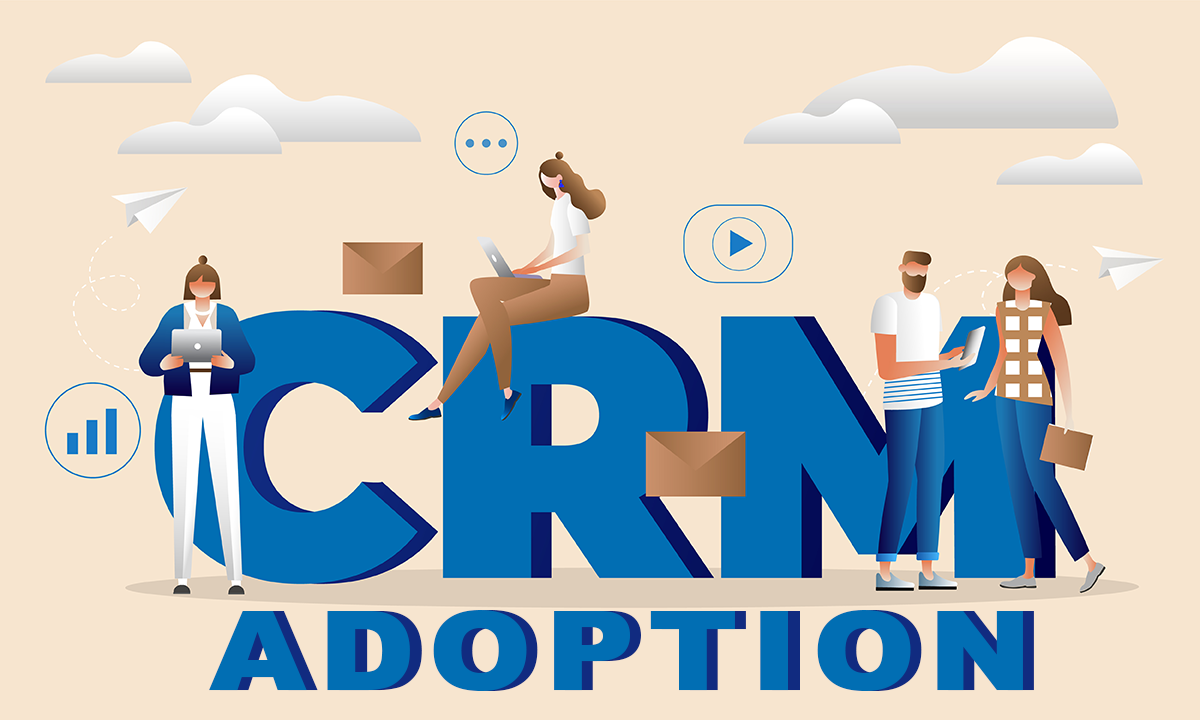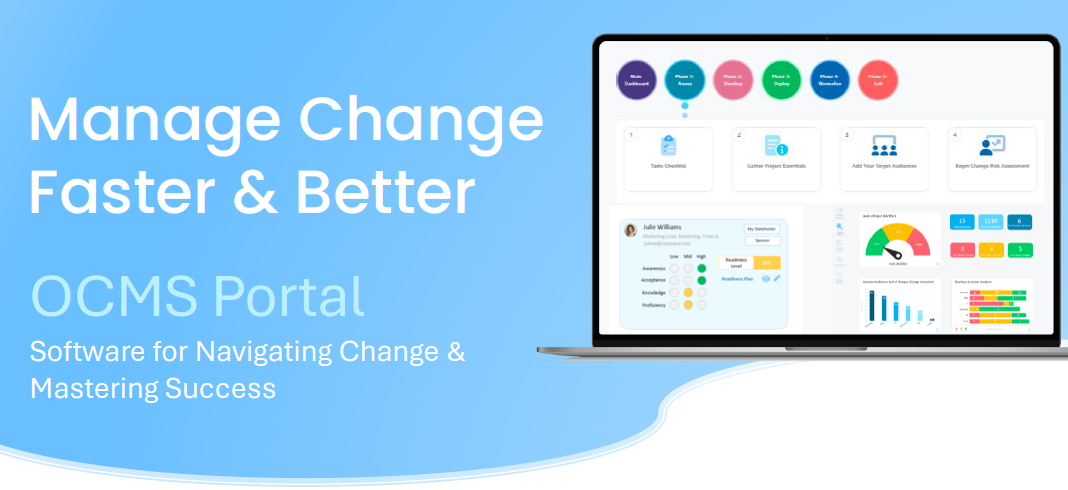How Change Management Leads to Successful CRM Implementation
One of the most impactful organizational initiatives is adopting customer relationship management technology. A Customer Relationship Management (CRM) system change doesn’t only impact your employees utilizing the system, it also has a direct impact on customers.
Picture this: Your organization has invested in a cutting-edge CRM implementation solution. The promises of streamlined processes, enhanced customer insights, and revenue growth are tantalizing.
But here’s the catch—the technology alone won’t deliver these benefits. It’s the people (your employees), their mindset, and their willingness to embrace change that will determine the CRM’s success.
Here’s where change management CRM adoption support comes into play.

In this playbook, we’ll delve into the art and science of change management specifically tailored for CRM user adoption. Whether you’re a seasoned change manager or a new OCM practitioner, this playbook will equip you with the tools to navigate the winds of change and steer your organization toward CRM system implementation triumph.
Watch a summary below:
Story Highlights
|
Why Does CRM Adoption Fail Without Change Management?
Let’s face it, change can be disruptive. You can’t just spring a new customer relationship management implementation on employees without any warning and expect them to start using it.
Without proper change management, CRM implementation can fall victim to several costly pitfalls:
- User Resistance: Employees accustomed to existing processes might resist adopting a new system, leading to data inconsistencies and hindering CRM effectiveness.
- Training Gaps: Inadequate training leaves users overwhelmed and unsure how to navigate the CRM. Confused users often revert to old habits, undermining the system’s impact.
- Data Quality Issues: Migrating customer data to the new system without mapping each impacted role’s workflow can lead to problems with accuracy and incomplete records, hindering effective customer management.
- Communication Silos: Lack of clear and consistent communication throughout the customer relationship management implementation can breed confusion and anxiety among users, fostering a negative perception of the CRM software implementation.
The Benefits of a Successful Change Management CRM Approach
Using a structured change management process ensures you’re meeting CRM adoption best practices. Change management is all about enabling people impacted by an organizational initiative to change successfully.
By deploying this change management playbook, you can unlock several benefits for your CRM implementation:
- Increased User CRM Adoption: Engaged and empowered users are more likely to adopt the CRM and utilize its features effectively.
- Improved Data Quality: Through proper training and support, users become more proficient in using the CRM, fostering accurate data entry, and leading to more reliable customer information within the CRM.
- Enhanced Customer Interactions: With a user-friendly CRM and trained staff, organizations can deliver more personalized and efficient customer service experiences.
- Data-Driven Decision Making: Effective CRM implementation adoption can provide valuable customer data and insights to drive informed and strategic business decisions.
Do you have any questions about CRM adoption best practices or how change management fits into a CRM system implementation? Please reach out and let us know.
The Change Management Playbook for Successful CRM Implementation
By implementing a strategic change management plan alongside your customer relationship management implementation, you can ensure user buy-in, maximize adoption rates, and unlock the CRM’s full potential. Here’s your playbook.
1. Define Your Change Goals and Objectives
- Identify CRM Objectives: What do you aim to achieve with the CRM? This could be improved sales pipeline management, enhanced customer service experiences, or data-driven marketing campaigns.
- Define CRM Adoption Metrics: Establish quantifiable metrics to measure user adoption of the new system. This could include login frequency, data entry rates, or utilization of specific CRM features.
2. Identify Stakeholders and Craft a Communication Plan
- Map Stakeholders: Identify all individuals impacted by the process of implementing the CRM, including sales reps, customer service agents, marketing teams, and management. This is your “Target Audience.”
- Tailored Communication: Develop targeted communication strategies for different user groups. Consider user needs, communication preferences, and potential concerns when crafting messages. Utilize a variety of channels like town halls, email updates, video tutorials, and user guides.
- Transparency is Key: Maintain open and transparent communication throughout the process of implementing the CRM. Address user concerns proactively and provide clear timelines for implementation.
3. Invest in User Training and Enablement
- Comprehensive Training Programs: Develop training programs that are comprehensive and cater to the specific needs of each user group. Offer a mix of learning formats like in-person sessions, online tutorials, and on-the-job support to address different learning styles.
- Focus on User Benefits: Highlight how the CRM will benefit individual users – increased productivity, improved customer interactions, or easier reporting. This increases motivation for engagement and can increase CRM adoption.
- Empowerment Through Resources: Provide users with readily accessible resources such as cheat sheets, FAQs, or user communities to support them as they navigate the CRM system implementation.
4. Address Resistance Proactively
- Anticipate Concerns: Identify potential concerns users might have regarding the change. Develop strategies to address these concerns, highlight the benefits of the CRM, and provide clear channels for feedback.
- Champion Support System: Create a change champion support system where users can ask questions and seek help. This could include dedicated help desks, peer-to-peer mentorship programs, or supervisory support.
- Celebrate Early Wins: Recognize and celebrate early successes achieved through CRM usage. This reinforces the value of the system and motivates continued adoption.
5. Monitor Progress and Adapt Your Approach
- Continuous Monitoring: Regularly monitor CRM adoption metrics and utilization of key CRM features using predefined KPIs.
- Gather User Feedback: Actively solicit feedback from users through surveys, focus groups, or one-on-one conversations. Utilize this feedback to identify areas for improvement and adapt your training materials or communication strategies accordingly.
6. Foster a Culture of Continuous Improvement
- Reinforcement Strategies: Keep the momentum going beyond initial training. Implement ongoing reinforcement strategies such as recognition programs, incentives for reaching performance goals, or leader visibility demonstrating strong CRM adoption.
- Data-Driven Decision Making: Utilize data analytics capabilities within the CRM to track customer interactions, identify trends, and measure performance. Share these insights with users to demonstrate the impact of the successful CRM implementation to promote continued enthusiasm.
- Embrace User Feedback: Continuously solicit feedback from users and incorporate their ideas for future improvements to the CRM system and work processes. This fosters a sense of ownership and engagement among users.
Please let us know if you have any questions or feedback about how to increase CRM adoption or the change management process of implementing CRM changes. We’d love to hear from you!
Building a CRM Change Champions/Agents Team
Remember, a successful CRM system implementation isn’t just about technology. It’s about people. Building a CRM change agent or champion network comprising enthusiastic users from different departments can play a pivotal role:
- Leading by Example: Champions can demonstrate the benefits of the CRM through their own usage and encourage positive peer-to-peer influence.
- Providing On-the-Ground Support: Champions can offer informal guidance and support to colleagues struggling with navigating the CRM, complementing formal training programs.
- Promoting Continuous Learning: Champions can stay up to date on new CRM features and share their knowledge with others through peer mentorship programs or internal knowledge-sharing sessions.
Change Management: The Key to CRM Implementation Success
By adopting a well-defined change management plan, you can transform your CRM system implementation from a tedious technical migration into a positive organizational transformation. By engaging your people, empowering them with the necessary skills, and fostering a culture of continuous improvement, you can turn your CRM users into enthusiastic advocates, unlocking the system’s full potential and ROI and driving business growth through enhanced customer relationships.
Change Management CRM Adoption Software
Tracking the success of your CRM software implementation through CRM user adoption is important. The OCMS Portal is an all-in-one change management software that makes it easy.
Add and track custom CRM adoption metrics, survey users to gain insights, and handle all your change management communication, training, and engagement tasks. This powerful change management tool sets you up with CRM adoption best practices.
FAQ: How To Increase CRM Adoption
How can you improve the outcome of adopting customer relationship management technology?
Implementing the CRM technology alone without user enablement often causes CRM initiatives to fail. It’s the people (your employees), their mindset, and their willingness to embrace change that will determine the CRM implementation’s success. This is why they need to be enabled through a change management CRM adoption plan.
What are some of the steps for using change management in the process of implementing CRM technology?
Change management steps for enabling users in successfully adopting customer relationship management technology include:
Define Your Change Goals and Objectives
Identify Stakeholders and Craft a Communication Plan
Invest in User Training and Enablement
Address Resistance Proactively
Monitor Progress and Adapt Your Approach
Foster a Culture of Continuous Improvement
What does a CRM champion do and how does it help customer relationship management implementation?
Building a CRM change agent or champion network comprising enthusiastic users from different departments can play a pivotal role in successful CRM implementation. This network of peers demonstrates the benefits of the CRM through their own usage, can offer informal guidance and support to colleagues, and share their knowledge with others to increase CRM user adoption.
Note: Content on OCM Solution's ocmsolution.com website is protected by copyright. Should you have any questions or comments regarding this OCM Solutions page, please reach out to Ogbe Airiodion (Change Management Lead) or the OCM Solutions Team today.
External Sources: stock.adobe.com





